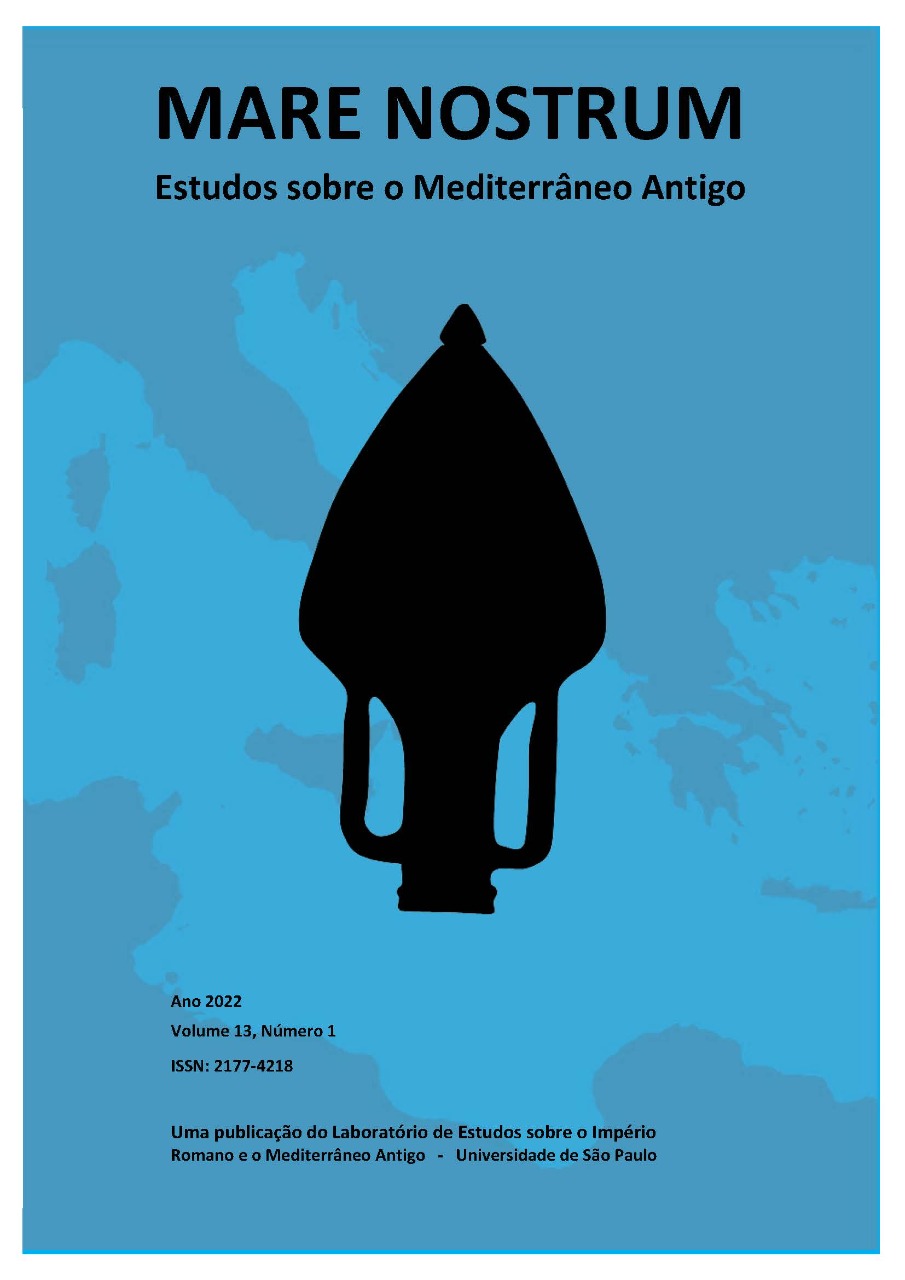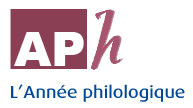Between Egypt and Azania: Afro-Asiatic Connection in the Periplus of the Erythraean Sea
DOI:
https://doi.org/10.11606/issn.2177-4218.v13i1p123-145Keywords:
Periplus of the Erythraean Sea, Africa, global history, AzaniaAbstract
The aim of this article is to analyse the processes of contact and integration between northeast Africa and different regions of Africa and Asia, focusing specifically on an anonymous text from the 1st century AD known as the Periplus of the Erythraean Sea. This document, generally read from a romanocentric perspective, will be interpreted with the analytical models of Global History. Hence, this analysis expects to show that the Egyptian ports of the Red Sea were part of an ancestral Afro-Asiatic connective system – of which the Roman Empire was not the creator, but a late participant.
Downloads
References
Fontes Primárias
Burstein, S. (Ed.). (1989). Agatharchides of Cnidus, on the Erythraean Sea. The Hakluyt Society.
Casson, L. (Ed.). (1989). The Periplus Maris Erythraei: Text with Introduction, Translation, and Commentary. Princeton University Press.
Figuras
Figura 1: PHGCOM (2007). Locations, names and routes of the Periplus of the Erythraean Sea (1st century CE). Wikimedia Commons sob licença GNU Free Documentation License. https://commons.wikimedia.org/wiki/File:Map_of_the_Periplus_of_the_Erythraean_Sea.jpg. Acessado em 05/06/2022.
Figuras 2: Bernhard, Hans (1976). Ägyptische Expedition nach Punt während der Regierung von Hatschepsut. Wikimedia Commons sob licença GFDL-CC-BY-SA-all. https://commons.wikimedia.org/wiki/File:Punt2.JPG. Acessado em 05/06/2022.
Figuras 3: Seland, E. H. (2016). The Periplus of the Erythraean Sea: A Network Approach. Asian Review of World Histories, 4(2), p. 191-205. DOI:10.12773/arwh.2016.4.2.191.
Figura 4: Seland, E. H. (2016). The Periplus of the Erythraean Sea: A Network Approach. Asian Review of World Histories, 4(2), p. 191-205. DOI:10.12773/arwh.2016.4.2.191.
Bibliografia Crítica
‛Abdullah, Y. M. (1995). The City of al-Sawā in the Periplus of the Erythraean Sea. Arabian Archaeology and Epigraphy, 6(4), p. 259-269.
Arnaud, P. (2012). Le Periplus Maris Erythraei: une oeuvre de compilation aux préoccupations géographiques. Topoi. Oriente-Occident, 11, p. 26-61.
Balanda, S. (2006). The so-called “Mine of Punt” and its Location. Journal of the American Research Center in Egypt, 42, p. 33-44.
Bard, Kathryn A. & Fattovich, Rodolfo. (2018). Seafaring expeditions to Punt in the Middle Kingdom: Excavations at Mersa/Wadi Gawasis, Egypt. Brill.
Bard, K. A. & Fattovich, R. (2013). In S. Chrisomalis & A. Costopoulos (Eds.). Human Expeditions, Inspired by Bruce Trigger (pp. 3-11). University of Toronto Press.
Bradbury, L. (1996). Kpn-boats, Punt Trade, and a Lost Emporium. Journal of the American Research Center in Egypt, 33, p. 37-60. DOI: 10.2307/40000604.
Brozyna, J. M. (1999). The Incense Route: a Study of its Origin and Development [Dissertação de mestrado não publicada]. San Jose State University.
Cassol, L. (1986). The location of Tabai (Periplus Maris Erythraei 12–13). The Journal of Hellenic Studies, 106, p. 179–182. DOI: 10.2307/629652
Chami, F. A., & Msemwa, P. J. (1997). A New Look at Culture and Trade on the Azanian Coast. Current Anthropology, 38(4), p. 673–677. DOI:10.1086/204654.
Conrad, S. (2019). O que é História Global?. Edições 70.
Contenson, H. (2010). A cultura pré-axumita. In G. Mokhtar (Ed.). História Geral da África II: África Antiga (pp. 351-374). UNESCO.
Creasman, P. P. (2014). Hatshepsut and the Politics of Punt. African Archaeological Review, 31(3), p. 395–405. DOI: 10.1007/s10437-014-9160-9
Datoo, B. A. (1970). Rhapta: the Location and Importance of East Africa’s first Port. Azania: Archaeological Research in Africa, 5(1), p. 65–75. DOI: 10.1080/00672707009511528
Fillafer, F. L. (2017). A world connecting? From the unity of History to Global History. History and Theory, 56(1), p. 3–37. DOI: 10.1111/hith.12000
García, J. C. M. (2016). Trade and Power in Ancient Egypt: Middle Egypt in the Late Third/Early Second Millennium BC. Journal of Archaeological Research, 25, p. 87-132.
Hikade, T. (2006). Expeditions to the Wadi Hammamat during the New Kingdom. The Journal of Egyptian Archaeology, 92(1), p. 153–168. DOI: 10.1177/030751330609200105.
Horton, M. (1990). The Periplus and East Africa. Azania: Archaeological Research in Africa, 25(1), p. 95–99. DOI: 10.1080/00672709009511414.
Huang, H. The Route of Lapis Lazuli: Lapis Lazuli Trade from Afghanistan to Egypt during Mid-Late Bronze Age. Advances in Social Science, Education and Humanities Research (ASSEHR), 183, p. 391-399.
Júnior, J. J. G. dos S. & Sochaczewski, M. (2017) História global: um empreendimento intelectual em curso. Revista Tempo, 23(3), p. 482-502. DOI: 10.1590/TEM-1980-542X2017v230304.
Kirwan, L. P. (1986). Rhapta, Metropolis of Azania. Azania: Archaeological Research in Africa, 21(1), p. 99–104. DOI: 10.1080/00672708609511370
Korotayev, A. V. (1996). Pre-Islamic Yemen: Socio-political Organization of the Sabaean Cultural Area in the 2nd and 3rd Centuries AD. Harrassowitz Verlag.
Manzo, A. (2011). Punt in Egypt and Beyond: Comments on the impact of maritime activities of the 12th Dynasty in the Red Sea on Egyptian crafts with some historical and ideological thoughts. Ägypten und Levante, 21, p. 71-85.
Morales, F. A. & Silva, U. G. da. (2020). História Antiga e História Global: afluentes e confluências. Revista Brasileira de História (São Paulo), 40(83), p. 125-150. DOI: 10.1590/1806-93472020v40n83-06.
O'Connor, D. & Quirke, S. (Eds.). (2003). Mysterious Lands. UCL Press.
Phillips, J. (1997). Punt and Aksum: Egypt and the Horn of Africa. The Journal of African History, 38(3), p. 423–457. DOI: 10.1017/s0021853797007068
Pinto, O. L. V. (2022). A diplomacia das feras: a África ao sul do Saara, o império de Axum e os caminhos para uma Antiguidade Tardia multipolar. Heródoto: Revista do Grupo de Estudos e Pesquisas sobre a Antiguidade Clássica e suas Conexões Afro-asiáticas, 6(2), p. 173–196. DOI: 10.34024/herodoto.2021.v6.13931.
Purcell, N. (2015). Periploi, 'voyages around'. Oxford Classical Dictionary.
Raunig, W. (1970). Die Versuche einer Datierung des Periplus maris Erythraei. Mitteilungen der anthropologischen Gesellschaft in Wien, 100, p. 231–42.
Robin, C. (1991). L'Arabie du Sud et la Date du Périple de la Mer Érythrée (Nouvelles Données). Journal Asiatique, 279, p. 1-30.
Saleh, A.-A. (1973). An Open Question on Intermediaries in the Incense Trade during Pharaonic Times. Orientalia, 42, p. 370-382.
Schoff, W. (2010). The Eastern Iron Trade of the Roman Empire. Gorgias Press.
Seland, E. H. (2016). The Periplus of the Erythraean Sea: A Network Approach. Asian Review of World Histories, 4(2), p. 191-205. DOI: 10.12773/arwh.2016.4.2.191.
Silva, M. C. da (2020). Uma História Global antes da Globalização? Circulação e Espaços Conectados na Idade Média. Revista de História (São Paulo), 179, p. 1-19. DOI: 10.11606/issn.2316-9141.rh.2020.160970.
Silva, U. G. da. (2019). Outra História Global é possível? Desocidentalizando a História da Historiografia e a História Antiga. Esboços: Histórias em contextos globais, 26(43), p. 473-485. DOI: 10.5007/2175-7976.2019.e65429.
Tomber, R. (2004). Rome and South Arabia: new artefactual evidence from the Red Sea. Proceedings of the Seminar for Arabian Studies, 34, p. 351-360.
Turner, P. J. & Cribb, J. E (2009). Numismatic evidence for the Roman trade with Ancient India. In J. Reade (Ed.). The Indian Ocean in Antiquity (pp. 309-320). Routledge.
Valerian, V. & Chami, F. (2019). In Search of the Lost Metropolis of Azania – Rhapta Continued Research In Misimbo, Rufiji. Studies in the African Past, 10.
Wickramasinghe, C. S. M. (2018). A Study of Anthropological and Ethnographical Information in the Periplus of the Erythraean Sea. Indian Historical Review, 45(1), 151–167. DOI: 10.1177/0376983617754114.
Whitcomb, D. (1996). Quseir al-Qadim and the Location of Myos Hormos. Topoi, 6(2), p. 747–742. DOI: 10.3406/topoi.1996.1693.
Young, G. K. (1997). The Customs-Officer at the Nabataean Port of Leuke Kome (“Periplus Maris Erythraei” 19). Zeitschrift für Papyrologie und Epigraphik, 119, p. 266-268.
Downloads
Published
Issue
Section
License
Copyright (c) 2022 Otávio Luiz Vieira Pinto

This work is licensed under a Creative Commons Attribution 4.0 International License.
Responsibility for the content published by Mare Nostrum rests exclusively with the author(s) of such content.
The reproduction of the texts published by Mare Nostrum is licensed according to Creative Commons license Attribution-NonCommercial 4.0 International (CC BY-NC).
Authors who publish with this journal agree to the following terms:
- Authors retain copyright and grant the journal right of first publication with the work simultaneously licensed under a Creative Commons Attribution License that allows others to share the work with an acknowledgement of the work's authorship and initial publication in this journal.
- Authors are able to enter into separate, additional contractual arrangements for the non-exclusive distribution of the journal's published version of the work (e.g., post it to an institutional repository or publish it in a book), with an acknowledgement of its initial publication in this journal.
- Authors are permitted and encouraged to post their work online (e.g., in institutional repositories or on their website) prior to and during the submission process, as it can lead to productive exchanges, as well as earlier and greater citation of published work (See The Effect of Open Access).









